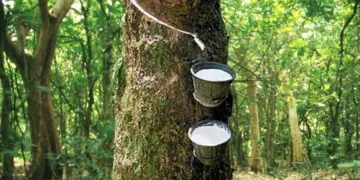Asian rubber markets settled mixed last week amid negative and positive market sentiments that persisted during the week. A convincing victory made by LDP in the latest Japanese election on 16 December, signaling an aggressive monetary easing policy in Japan, would be prevailed, and this could boost the Japanese economy and domestic demand in particular. Meanwhile, a weaker yen and Chinese government policy to cut import tax for rubber were likely to support rubber prices during the week. In the meantime, the US fiscal crisis stalled, and it brought about uncertainty to the market.
IRCo’s DCP ended the week a bit higher at 302.00 US cents/kg on Friday, or 0.21 US cents/kg (0.07%) higher than its initial price at 301.79 US cents/kg on Monday. In the meantime, Thai RSS-3 also rose to 315.94 US cent/kg on Friday from 312.93 US cents/kg on Monday, or gained 3.01 US cents/kg (0.96% higher). Similarly, Thailand STR-20 also climbed to 294.42 US cents/kg on Friday, or up 3.04 US cents/kg, or 1.04% higher than its settlement price at 291.38 US cents/kg on Monday.
On the other hand, Indonesia SIR20 settled 2.00 US cents/kg lower at 290.00 US cents/kg on Friday, or lost 0.67% compared with its settlement price at 292.00 US cents/kg on Monday. Furthermore, Malaysia SMR20 also fell and finished the week at 295.00 US cents/kg on Friday, or lost 4.00 US cents/kg (1.34% lower) compared with its initial price at 299.00 US cents/kg on Monday.
The benchmark rubber contract for June delivery on TOCOM settled 3.40 yen/kg higher at 287.60 yen/kg on Friday, or gained 1.20% compared with its settlement price at 284.20 yen/kg on Monday. In addition, AFET RSS-3 for July delivery also rose slightly from 101.80 THB/kg on Monday to 102.10 THB/kg on Friday, or gained 0.30 THB/kg, or up 0.29%. On the contrary, Shanghai Futures Commodity Exchange for May delivery closed a bit lower at 25,065.00 Yuan/ton, or 190.00 Yuan/ton (0.75%) lower than its settlement price at 25,255.00 Yuan/ton on Monday.
NR supply is expected to be tight in the coming week as main rubber production regions inIndonesia are being disrupted by the rainy season, while main rubber plantation areas in southern Thailand and northern Malaysia are in the similar condition.
Source: IRCo




























